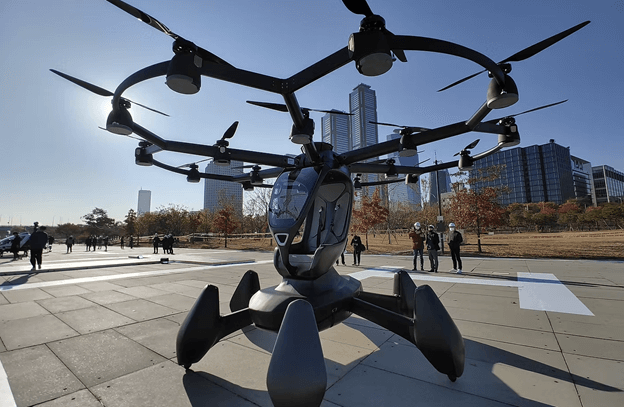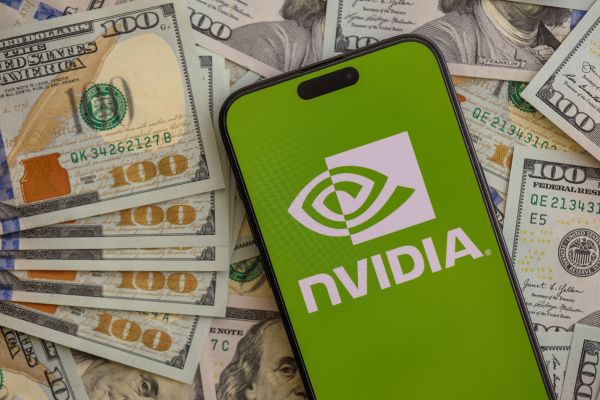
Posted October 24, 2025
By Davis Wilson
My Experience Test Piloting a “Flying Car”
Yesterday I test piloted a “flying car.”
It’s called the HEXA, built by LIFT Aircraft right here in Texas.
Technically, it’s an ultralight eVTOL (electric vertical takeoff and landing vehicle).

This vehicle has:
- Eighteen independent electric motors.
- One seat.
- A top speed of 62 miles per hour according to the investor presentation.
And the craziest part?
You don’t need a pilot’s license to fly it.
With an all–carbon fiber frame, the HEXA weighs just 432 pounds and qualifies under the FAA’s Powered Ultralight classification.
From Curiosity to Cockpit
I first heard about LIFT while researching Joby Aviation (JOBY) and Archer Aviation (ACHR) – two of the more established eVTOL players I’ve covered before.
So imagine my surprise when I discovered that LIFT was offering public flight experiences for just $200 within walking distance of my home in downtown Austin.
I jumped at the opportunity.
The signup process was easy. Dates were wide open. And who wouldn’t want to test-fly a prototype aircraft with 18 spinning propellers above their head??
Of course there was paperwork. A lot of it.
I’m pretty sure I signed away my rights and possibly my firstborn.
But the flight itself was unforgettable and gave me a front-row seat to the future of personal aviation.
Preflight
Weather threatened to delay the flight but conditions turned out fine and I was cleared to fly.
When I arrived, I was surprised by the size of the operation.
This wasn’t some backyard experiment.
Two other test pilots were checking in. One was an investor himself.
Engineers and ground crew were stationed around the site.
LIFT’s chief pilot was on hand.
Safety was clearly the top priority.
Preflight training was thorough with a military veteran leading the session.
The first half covered basic controls and flight plans.
The HEXA is surprisingly simple to operate. It’s essentially a joystick, five buttons, and two levers for turning and altitude.
One button for takeoff, one for return to base, one for landing.
The others? On and off.
After that came simulator training in VR where I practiced takeoffs, turns, and landings until I felt comfortable.

The most important thing to know? If you don’t touch anything the HEXA just hovers in place.
The Flight
Then it was time.
I put on a helmet with noise-canceling headphones and was strapped into a harness – two over-the-shoulder straps and one across the waist.
With a single tap, all 18 propellers roared to life.
Another tap of a button and the HEXA lifted itself to 20 feet automatically, stabilized using GPS, and then it was my turn to fly.

The joystick handled direction: forward, backward, left, right.
A thumb lever controlled altitude.
An index finger lever handled rotation.
The onboard display showed a live map, altitude, speed, and my geofenced flight zone.
The system even supports optional voice commands and touchscreen sliders.
For about five minutes I explored the airspace.
I circled the inside of the geofenced area two or three times, experimenting with altitude and even rotating quickly in place.
I could feel the HEXA responding instantly to my inputs, smooth and precise.
Hovering felt effortless.
The aircraft maintained stability even when I tested abrupt maneuvers.
The sensation of controlling something so light yet powerful was exhilarating – like a drone, only you were inside it.
I could rise, descend, pivot, and bank gently without ever losing balance or confidence.
When my session ended I pressed two buttons and the HEXA automatically returned to base and landed itself.
I stepped off grinning ear to ear as the crew helped me out and swapped batteries for the next pilot.
A Glimpse of the Future
It might have only been a five-minute flight, but it felt like stepping into the future.
The technology is real and it works.
But like most revolutionary ideas, regulation is the bottleneck.
Under current FAA rules, ultralight and experimental aircraft cannot fly over populated areas, at night, or in bad weather.
That means for now, LIFT’s HEXA remains a demonstration experience… not a commuter vehicle.
Another major hurdle is infrastructure.
LIFT and other eVTOL companies don’t plan to sell these aircraft directly to consumers.
Instead, they’re developing networks of vertiports – dedicated takeoff and landing pads – to support on-demand commercial flight services much like how Uber or Lime Scooters operate today.
Expect this technology to roll out internationally before in the U.S.
Dubai, Saudi Arabia, China, and Singapore are laying the groundwork for large-scale eVTOL operations.
Still, things in the U.S. may be speeding up.
Last month, Transportation Secretary Sean Duffy unveiled a plan to fast-track Advanced Air Mobility Vehicles under a new initiative called the Electric Vertical Takeoff and Landing Integration Pilot Program.
It builds on President Trump’s executive order to strengthen America’s drone and air mobility industries.
The goal: accelerate the rollout of next-generation aircraft.
What’s different this time is momentum.
Former FAA administrator Billy Nolen left to join Archer Aviation.
Current FAA chief Mike Whittaker also came from the eVTOL industry.
The regulators who once hesitated are now leading the charge.
As the White House put it:
“Building a strong and secure domestic drone sector is vital to reducing reliance on foreign sources, strengthening critical supply chains, and ensuring that the benefits of this technology are delivered to the American people.”
Final Thoughts
Flying the HEXA wasn’t just thrilling. It was perspective-shifting.
This isn’t science fiction anymore.
The hardware exists. The software is here.
The only thing missing is regulatory clearance and scalable infrastructure.
If Washington follows through on its new initiatives, what I experienced yesterday could one day become as routine as calling an Uber.
For now, it’s still a novelty.
But one that offers a clear message: The future of flight is about to take off.
Sign Up Today for Free!
Davis Wilson is attempting to make $1 Million in the stock market.
He’s starting with just $100,000.
That’s a 10X return on his money.
And the best part… He’s going to be closely documenting his journey for you to follow along – full transparency.
You can follow along by signing up for The Million Mission absolutely free.
His high risk/high reward alerts will be delivered straight to your inbox.
That means…
- You’ll know exactly what Davis is investing in throughout his journey…
- You’ll know his immediate thoughts on breaking news that can impact his (and your) portfolio…
- And you’ll get the opportunity to follow along in your own portfolio (Up to you!).
Look for these alerts on Monday, Wednesday, and Friday to start, with an “Ask Davis” email on Saturday where he’ll respond directly to reader questions and feedback.
Inside each weekday alert, you'll find timely insights and investing opportunities that Davis is targeting in his own portfolio.
These will range from AI plays to cryptocurrencies to consumer staples.
No stocks or strategies are off limits for this audacious goal.
Can he pull it off?
Enter your email below to find out.

The $6 Trillion Sweater, NAK, and Don Jr.!
Posted November 01, 2025
By Davis Wilson

How About a Friendly Wager?
Posted October 31, 2025
By Davis Wilson

Do or Dye: Crucial Lesson From "Dr. Doom"
Posted October 29, 2025
By Davis Wilson

Calendar Reminder: AI Bubble (Wednesday, October 29)
Posted October 27, 2025
By Davis Wilson

To Short Squeezes and Beyond(Meat)!
Posted October 22, 2025
By Davis Wilson


